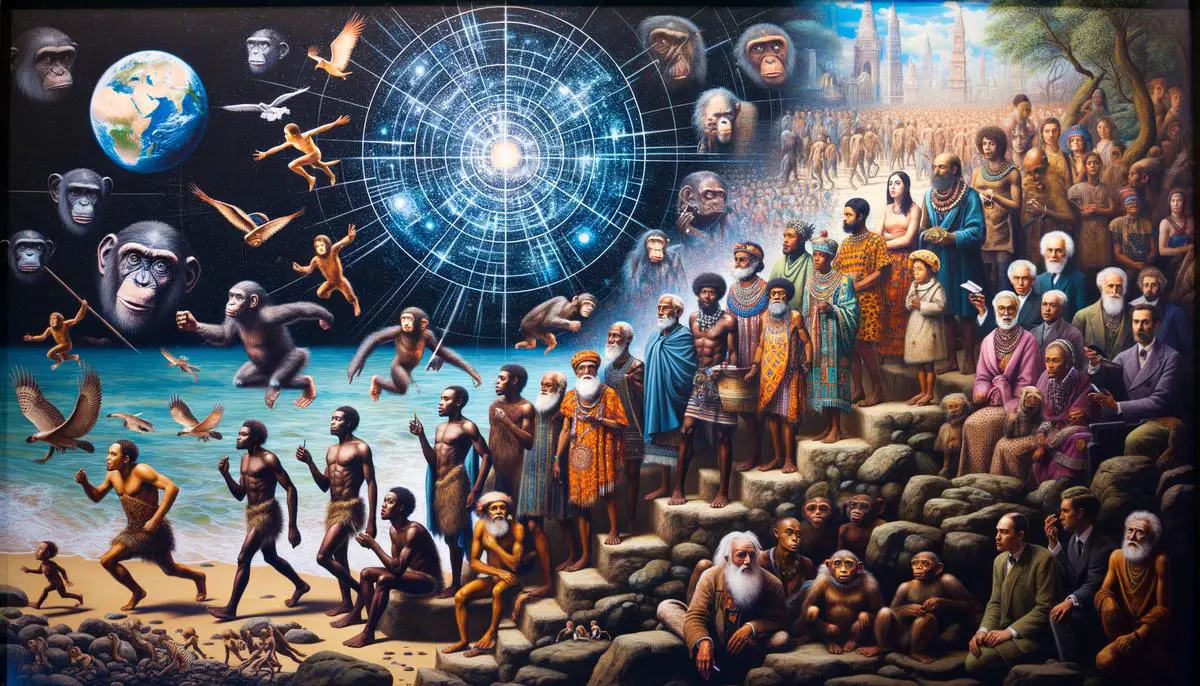Homo Sapiens Evolution
Homo sapiens, the pinnacle of human evolution, emerged approximately 300,000 years ago from Homo heidelbergensis, a possible common ancestor shared with extinct Neanderthals. The earliest known Homo sapiens fossils, found in sites like Jebel Irhoud in Morocco and Omo Kibish in Ethiopia, present a mix of modern and primitive traits, showcasing the gradual transition from archaic to contemporary features.
Fossils like those found in Florisbad, South Africa, dated around 260,000 years ago, provide further evidence of the morphological bridge between heidelbergensis and modern humans. Physical attributes also evolved with shifts in behavior and climate adaptations, such as the development of modern human body proportions with longer limbs and narrower pelvis.
Genetic studies support these tales of evolution, tracing gene flows and intermixing populations. DNA findings suggest notable interbreeding events among diverse Homo sapiens groups and with Neanderthals and Denisovans, contributing to a complex genetic mosaic that helped early humans adapt to various global environments.
Emerging technologies around 100,000 years ago, such as innovative tools crafted for hunting and gathering, offer glimpses of advancing cognition and social structures among early modern humans. These pivotal transitions reflect how Homo sapiens not only survived diverse challenges but also inhabited and modified various landscapes, laying the foundation for future generations.1
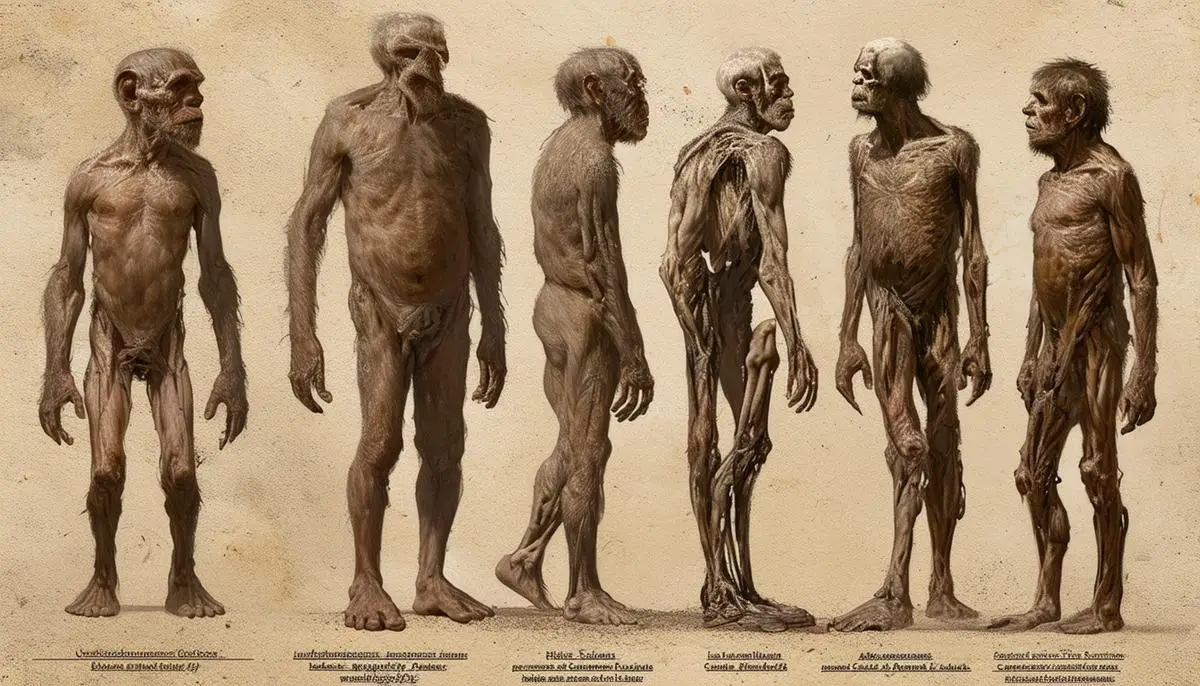
Spread and Survival of Homo Sapiens
Approximately 60,000 to 70,000 years ago, Homo sapiens began migrating out of Africa, a pivotal event referred to as the "Out of Africa" theory. This expansion led to Homo sapiens becoming the predominant form of hominin life across the globe. The intermingling of Homo sapiens with Neanderthals and Denisovans is one of the most captivating chapters of human migration. Skeletal and genomic evidence indicates significant interbreeding, particularly in regions now known as Europe and Asia.
Through interbreeding, traits helpful in northern climates, such as a strong immune response, were acquired by modern humans, aiding their adaptation to diverse ecosystems beyond their African roots.2 In Eurasia, contact with Neanderthals, who were well-adapted to cold European climates, and less frequently with Denisovans, paints a picture of competition and collaboration.
As Homo sapiens migrated further into different regions, they faced varied environments, from the icy landscapes of northeastern Siberia to the lush woods of Southeast Asia. Each environment posed unique challenges, prompting further evolution and adaptation. The remnants of this dispersal can be seen in the genetic footprint left across modern populations, preserving a record of those who migrated back to Africa and adding rich intricacy to our understanding of human history.
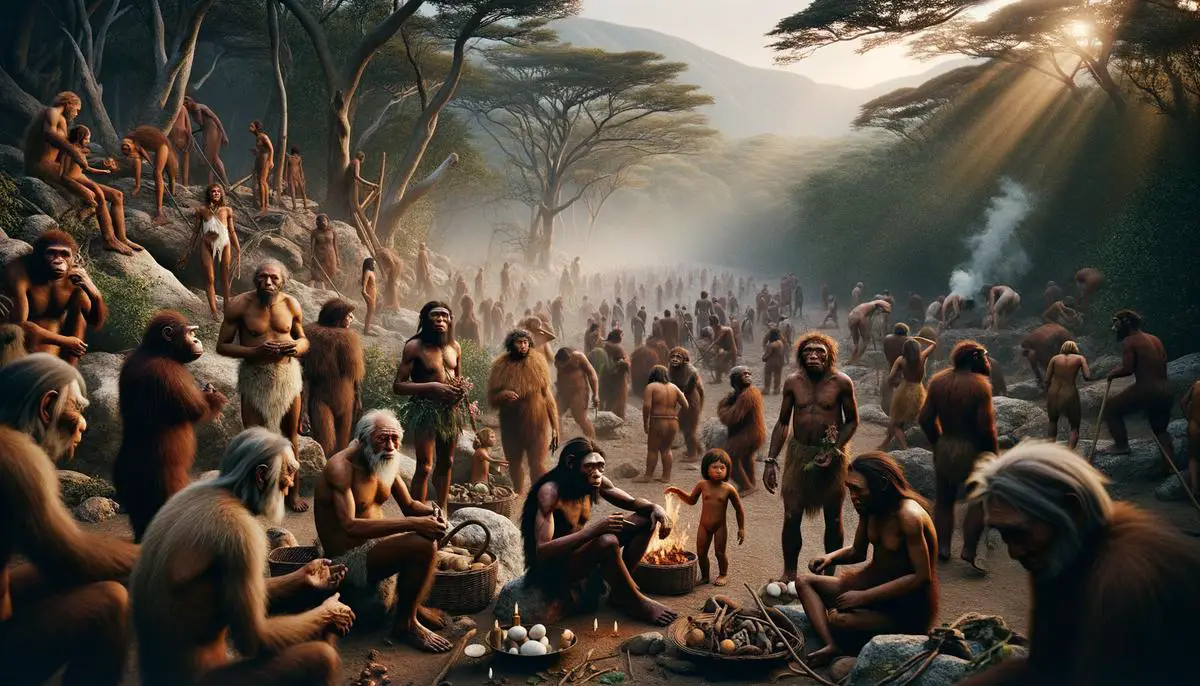
Cultural and Technological Advancements
Advances in the cultural and technological landscapes played pivotal roles in the ascendancy of Homo sapiens over other hominin species. The development of versatile tools, artistic expression, and symbolic behaviors were critical areas of progress.
The progressive tool-making capabilities of Homo sapiens support much of their success and adaptability. Early evidence of stone tool use, often referred to as "Mode 1" technology, involved simple chopping and cutting instruments. As cognitive abilities advanced, so did their tool kits. By approximately 250,000 to 300,000 years ago, during "Mode 3" periods, they had developed more complex stone tools, allowing for the creation of diverse artifact types for hunting and processing animal skins and food.
The ability to use fire, evident from around 400,000 years ago, revolutionized daily life. Fire provided warmth in colder climates, enabled the cooking of food, and contributed to physiological changes such as reduced jaw sizes over generations.3 These enhancements led to improved energy efficiencies, health, and social cohesion around communal hearths.
Artistic expressions, dating back some 100,000 years, represent complex cognitive and cultural behaviors. Art held symbolic meanings, enhancing group identity and supporting spiritual or communal beliefs essential for binding large social groups. Engravings on bone and eggshells suggest that art functioned as early forms of communication and education.
Personal adornments, prevalent around 70,000 to 100,000 years ago, provide insights into societal structures and the emergence of social status distinctions. Symbolic behavior extended to the careful interment of the dead, indicating a belief system that considered life beyond death and strengthened group ties.
Each advance represents a multifaceted response to living in dynamic and challenging environments, putting Homo sapiens at an advantage compared to other contemporaneous hominin species through enhanced adaptability.
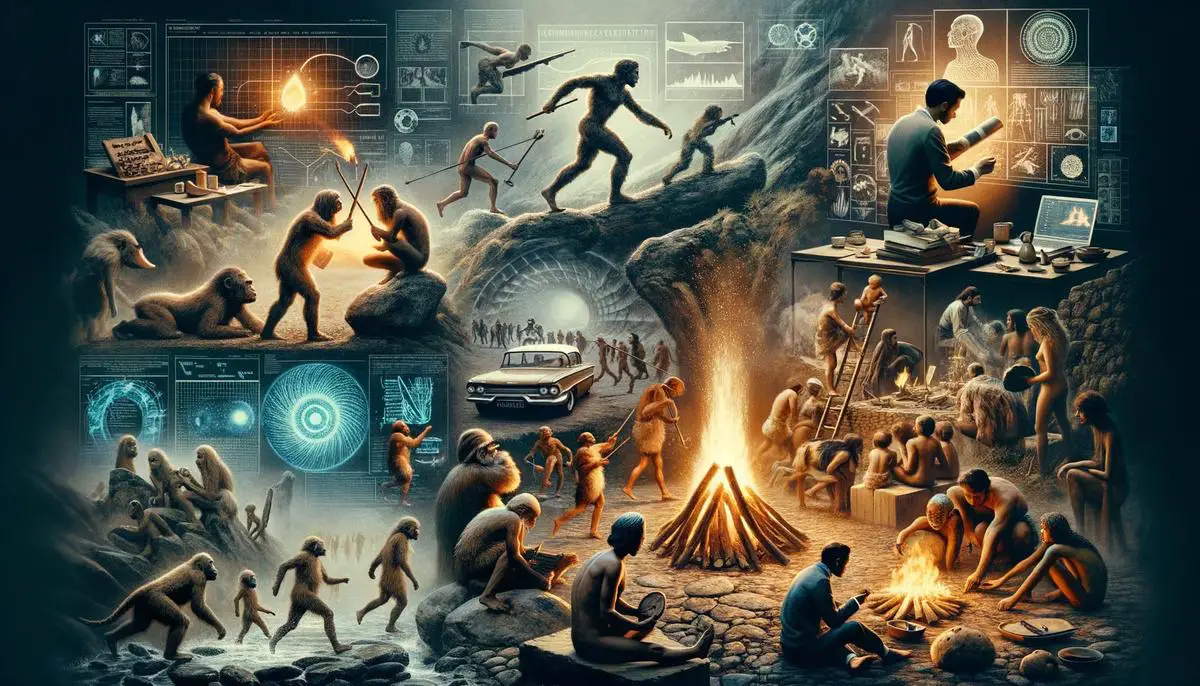
Genetic Evidence and Modern Research
Genetic evidence has proven instrumental in piecing together the migration and interbreeding patterns that have shaped modern Homo sapiens. Advancements in DNA analysis from both ancient fossils and existing human populations have allowed scientists to construct a more nuanced understanding of human evolution and the dynamic movements of our ancestors across the globe.
Genetic studies have provided evidence of the earliest Homo sapiens departing Africa around 60,000 to 70,000 years ago. The genetic markers carried by current-day non-African populations mirror those found in ancient remains across Asia and Europe, illustrating a continuation from an African genesis and corroborating the "Out of Africa" theory.
DNA analysis has shed light on the extensive interbreeding that occurred with Neanderthals and Denisovans. Modern non-Africans possess about 1-2% Neanderthal DNA, while some Asian and Oceanian populations have a higher proportion of Denisovan genetic material (up to 4-6%), hinting at complex historical interactions crucial to human survival.
This genetic intermingling has provided significant advantages to Homo sapiens, imparting traits that enhanced survival, such as diverse immunity responses and physiological adaptations vital for encountering new environments during global dispersal.
Modern research also refines our understanding of the timelines associated with these genetic exchanges. Sophisticated bioinformatics tools analyze the breakdown of telomeric DNA, allowing scientists to estimate the age of certain genetic mixtures traced back to key historical migrations and interactions.
Ongoing genetic research unearths facets of our past that propel the story of Homo sapiens into the richness of aggregate civilization, drawing an intricate picture of migration, adaptation, and interaction. These findings emphasize the shared human journey and the deep interconnectedness among humans and our ancient relatives.4
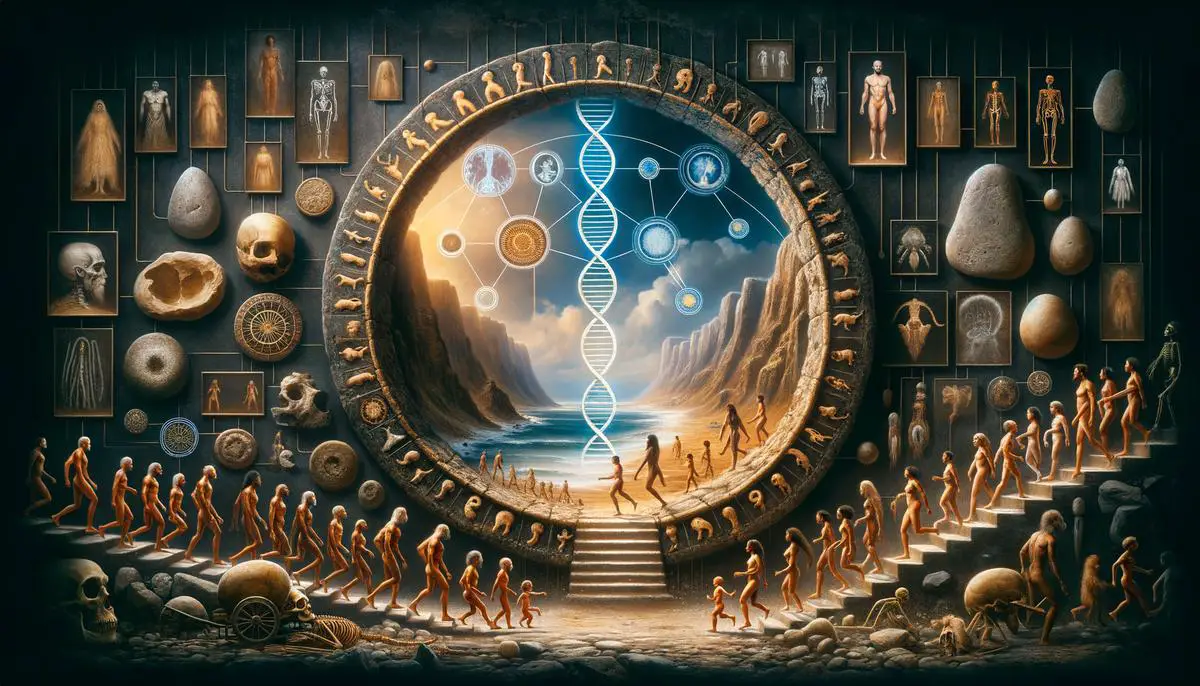
Challenges in Paleoanthropology
The classification of ancient fossils and definition of Homo sapiens continue to challenge paleoanthropologists and stoke extensive academic debate. The heart of the struggle lies in interpreting morphological variations found in the fossil record, which is a convoluted tapestry etched with millennia of evolutionary nuances and intermittent bursts of speciation.
Among the biggest hurdles is the incongruity within feature presentations that bleed across so-labeled species boundaries. A discovery of an archaic skull could exhibit a mixture of predicates deemed both primitive and advanced, typical of Homo sapiens yet resonant of H. heidelbergensis or H. neanderthalensis, making hard distinctions elusive and often debatable.
Paleoanthropologists confront the limitation inherent in fossils, which is a piecemeal preservation. Bone fragments' context, terrain-specific distortions, and varied preservation environments further complicate attempts to build clear and undisputed Homo lineage bridges. This highlights a quintessential paradox in paleoanthropology: the reliance on partial relics requiring subjective interpretation where complete records do not exist.
As new fossils are unearthed, the defined boundaries of H. sapiens shift or expand, feeding ongoing contentions around definitions. This elasticity determines how we understand human evolution's choreography and ancestral inheritance. New discoveries at intricate sites being concluded in East Africa and China propose alternative narratives on walking, tool utilization, and cognitive element emergence periods compared to what previously established European finds once restrained us within.
The defining features of Homo sapiens, as stipulated by existing casts and taxonomies, often vary among specimens due to natural diversity existing today. Implementing an equitable morphology-centered approach grows all the more challenging due to potential for unnoticed convergent evolution or parallel evolution paths across separated populations.
Acknowledging these challenges potentially erupts paradoxes within our mastery of human history. Researchers must consistently battle degradation of DNA in warmer climates, questioning biases from preservation favoring colder regions. Breaking grounds wade both technological advancements in visualization and data modeling and a cannonball towards multi-disciplinary integration, combining genetics, archaeology, anthropology, and computational biology.
This persistent fine-tuning of our contemporary understanding underscores not only the enormous geological timescale over which Homo has scattered and altered but embraces tenacity amid fragmented revelations—the chronicle of sapiens sprawled open, awaiting occlusions to be decrypted through persistent scholarship and rampant curiosities beneath Earth's surface layers.
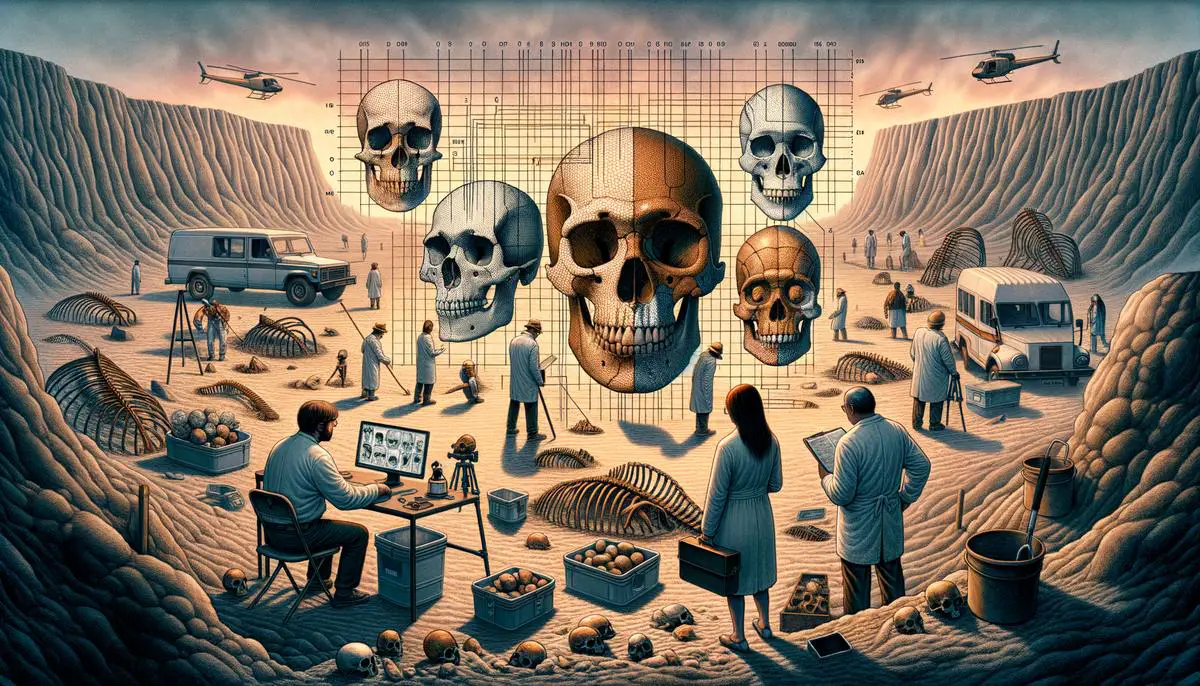
In the grand tale of human history, the adaptability and cultural intricacy of Homo sapiens are central to our species' global dominance. This enduring adaptability accentuates the essence of our journey—a relentless quest through generations that continues to shape our understanding of who we are and how we relate to the world around us.
- Hublin JJ, Ben-Ncer A, Bailey SE, et al. New fossils from Jebel Irhoud, Morocco and the pan-African origin of Homo sapiens. Nature. 2017;546(7657):289-292.
- Green RE, Krause J, Briggs AW, et al. A draft sequence of the Neandertal genome. Science. 2010;328(5979):710-722.
- Wrangham R. Control of fire in the Paleolithic: evaluating the cooking hypothesis. Curr Anthropol. 2017;58(S16):S303-S313.
- Nielsen R, Akey JM, Jakobsson M, Pritchard JK, Tishkoff S, Willerslev E. Tracing the peopling of the world through genomics. Nature. 2017;541(7637):302-310.
![]()
